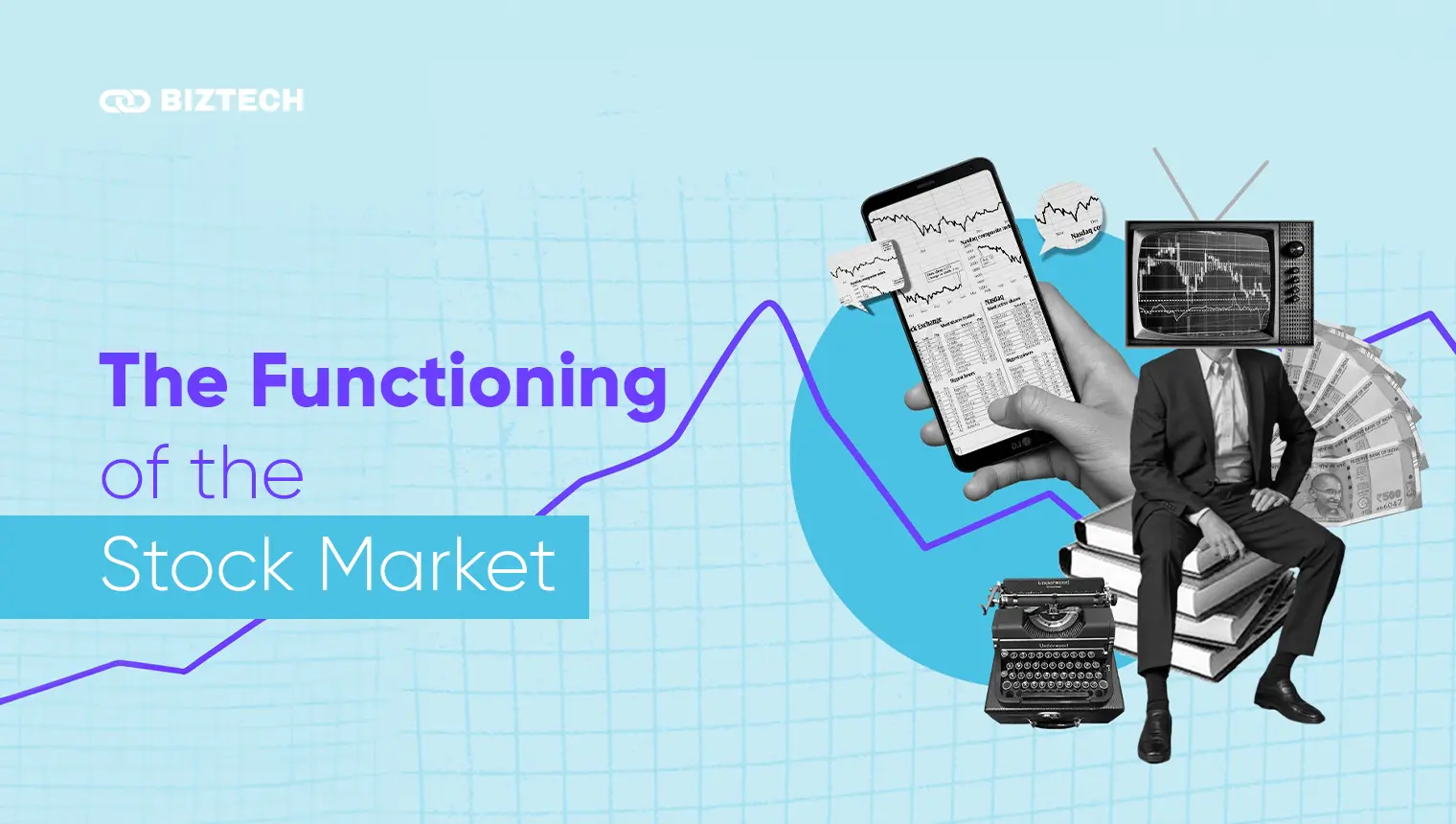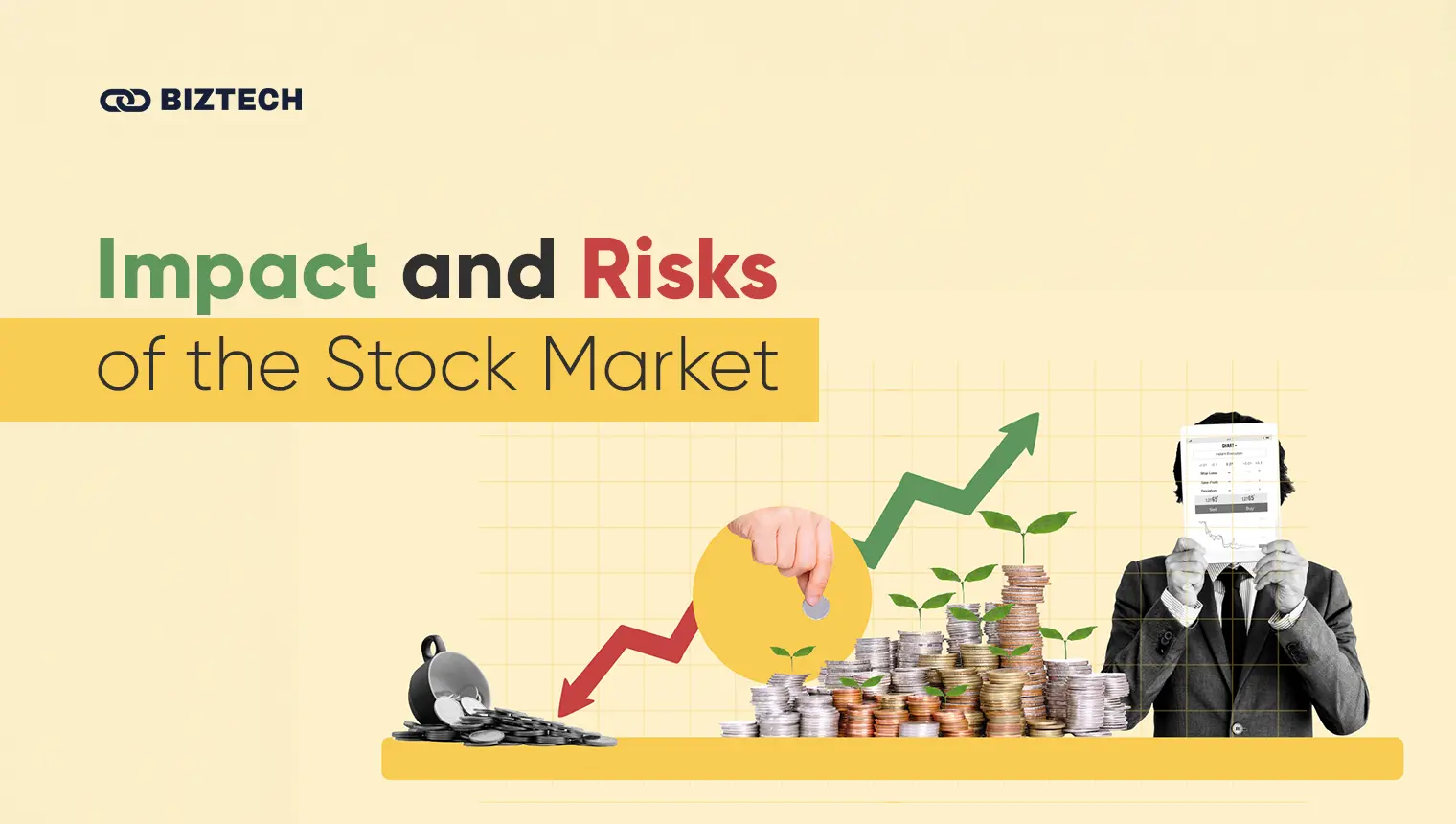Introduction
The stock market, usually called the equity market, is a vibrant, open market where people and organisations can issue, purchase, and sell stocks. It plays a significant role in the larger financial market ecosystem, which comprises several markets, including bonds, foreign exchange, derivatives, and more. The stock market is essential as a means for businesses to raise money for expansion and operations by selling ownership shares to investors. Investors purchase these shares when a corporation issues them with the hope of eventually recouping their investment through dividends or a sale at a higher price.
- Introduction
- The Functioning of the Stock Market
- Trading Mechanism
- Role of Stock Exchanges
- Determination of Stock Prices
- Investment in the Stock Market
- Issuance of Shares and IPOs
- Investment Strategies
- Portfolio Management
- Impact and Risks of the Stock Market
- Impact of Inflation
- Risks in the Stock Market
- Conclusion
- Frequently Asked Questions (FAQs)
The stock market is not only available on the US share market. It is a global system that includes a number of stock exchanges, including the London Stock Exchange in the UK, the New York Stock Exchange (NYSE), and NASDAQ in the United States. Every stock exchange has particular operating hours, which frequently raises queries like “what time does the stock market close?” Shares of publicly listed firms can be bought and sold on these exchanges, and indexes like the Dow Jones Industrial Average (DJIA), S&P 500, and NASDAQ Composite are used to measure their performance.
Stock market trends can be greatly influenced by investor sentiment and demand, which can result in events like stock market crashes, which are periods of extremely steep market declines. When the stock market declines, which is frequently the result of panic selling, people may wonder “why is the stock market going down?” or “what is the stock market crash?” Recessions and unemployment have traditionally been brought on by such occurrences, which have had enormous economic ramifications.
The stock market remains a vital aspect of global economic activity despite the inherent dangers and volatile periods, giving investors a platform to share in capital gains and allowing businesses to obtain the cash they need for expansion and innovation. Due to the possible influence on individual assets and the overall economy, it is always crucial to stay informed about “what is happening in the stock market”.
In the parts that follow, we will go into more detail about the inner workings of the stock market, examining its complexities and systems and clarifying the tactics and factors that affect investment choices.
The Functioning of the Stock Market
“What is the stock market?” is a common inquiry. You’re referring to a complicated system that has a number of functions in our international economy. Markets where securities, particularly shares of publicly traded corporations, are traded are collectively referred to as the stock market. This enormous network makes it possible to buy and sell these securities through either official exchanges or over-the-counter markets, giving investors in a free-market economy more open access. Major exchanges like the NYSE and Nasdaq are part of the US share market, which is also regulated by the SEC and other organisations.
Both primary and secondary markets are supported by the stock market. As a result, investors can trade existing assets and businesses are allowed to issue shares to the public for the first time through initial public offerings (IPOs). The market becomes a hub for a range of participants, including investors, traders, speculators, and hedgers, by assuring openness, liquidity, fair dealings, and efficient price discovery.
Every country’s stock market is governed by regional financial agencies, with the SEC in charge of the US market. The SEC and related organisations’ major objectives are to safeguard investors and uphold just markets in order to promote a climate that is favourable to capital development. Regulations, such as timely financial reporting and monitoring of business developments, apply to companies listed on these exchanges.
The stock market, notably the US share market, is essential to economic prosperity and growth. This rise is not necessarily linear, though; there can also be downturns or “stock market crashes” brought on by unforeseen market occurrences and strong feelings. The 2020 crash brought on by the COVID-19 pandemic would serve as an illustration of such an event. These instances serve as a reminder of the stock market’s fragile equilibrium and emphasise the value of cautious investment techniques and regulations.
Investment tactics include technical and fundamental analysis, passive index funds, and ethical investing, while taxation issues differ depending on the kind of securities and the length of the holding term. The U.S. stock market is open on weekdays from 9:30 a.m. to 4 p.m. EST, but the emergence of online trading platforms has allowed investors to interact with the market whenever they want.
The trading mechanism, the function of stock exchanges, and the setting of stock prices all work together to make the stock market run like a well-oiled machine. Investors can benefit from capital gains and dividends by participating in this market, which will help both their own financial situation and the whole economy.
Trading Mechanism
For those interested in the US share market or those who are wondering what is the stock market is, understanding the trading process is essential. The method that makes it possible for investors and traders to purchase and sell securities is the essence of the trading mechanism in a stock market.
The process of trading has become more effective with the establishment of stock exchanges on a global scale. Trading used to be done in actual places, but nowadays, the majority of exchanges use electronic platforms, significantly changing the way that trading is done. The market is now more accessible to a wider range of players, including small investors, as a result of the improvement in the speed, accuracy, and ease of trading activities.
An investor’s instruction to a broker to purchase or sell securities is known as an “order,” and it is one of the most important parts of the trading mechanism. Market orders, which are executed at the current market price, and limit orders, which are only executed if the security reaches a particular price, are two types of orders.
The stock market has a variety of participants, each of whom contributes in a different way to the trading process. These players actively buy and sell stocks, ranging from small-scale retail investors to institutional investors, including mutual funds, banks, and insurance firms.
It’s crucial to take into account how market regulators affect the trading system. To ensure fairness, transparency, and investor protection, market regulators like the Securities and Exchange Commission (SEC) in the US keep an eye on how the markets are run. The use of trading limits, often known as circuit breakers, is one way that regulators maintain market stability. These circuit breakers, which were introduced as a result of the 1987 stock market disaster, halt trade when certain thresholds are reached. When the market is stressed, the trading pause gives traders time to talk, which could stop panic selling.
Role of Stock Exchanges
Understanding the function of stock exchanges is essential for anyone with an interest in the US share market or who wants to know what is the stock market. Essentially, a stock exchange serves as a market where equities are bought and sold, playing a significant part in the financial ecosystem.
Fair trading is one of the main purposes of stock exchanges. They give market participants a regulated setting in which to trade securities. For instance, the Securities and Exchange Commission (SEC), which assures transparency, ethical business practises, and effective price discovery, regulates the stock markets in the US.
Additionally, stock exchanges increase market liquidity, making it simple for investors to acquire and sell shares. Because it affects how quickly and at what price an investor can enter or leave a position, this liquidity is a crucial consideration when making investment decisions.
Facilitating capital raising by businesses is another crucial role of stock markets. Initial public offerings (IPOs), in which businesses sell new shares to the general public, help achieve this. These equities can be traded by the general public on the secondary market following the IPO.
By acting as an economic barometer, stock exchanges also play a significant role in the economy. They give investors, creditors, and the government useful information by valuing assets based on supply and demand, which reflects the state of the economy.
Additionally, stock exchanges offer a trading platform for other products, such as derivatives, bonds, and stocks. varied exchanges have varied areas of expertise in terms of securities, and they can run on either electronic or auction-based platforms.
Determination of Stock Prices
One must examine the main factors that determine stock prices in order to comprehend what the stock market is completely and the complexities of the US stock market. Supply and demand are the main drivers of this intricate process, but other important influences include firm activity, the state of the economy, market mood, and more.
Role of supply and demand in determining stock prices.
Stock prices are fundamentally governed by the rules of supply and demand. The price of a stock typically rises when demand for it is high. In contrast, a stock’s price tends to decrease when the supply exceeds the demand.
Various factors may have an impact on how supply and demand interact in the stock market. For instance, the good news about a company may pique investor curiosity, which may enhance demand for its stock. On the other hand, bad news or poor financial results may deter investors, which will diminish demand and cause the price of the stock to decline.
The transition to electronic trading has improved efficiency in the stock market.
The efficiency of the stock market has undergone substantial changes as a result of the switch to electronic trading in financial markets. Rapid responses to fresh information are made possible, affecting investor mood and causing price adjustments. Additionally, centralising bid and offer pricing on electronic trading systems encourages fair competition and increases market transparency.
Notably, the distinction between traditional exchanges and over-the-counter (OTC) markets has become more hazy as a result of the migration to electronic trading. OTC markets frequently lack the openness and fairness that exchanges are recognised for, which can result in potential problems including illiquidity and difficulties appraising securities. By bringing some of the positive characteristics of conventional exchanges to OTC markets, the transition to electronic trading has attempted to allay these worries.
Investment in the Stock Market
Investment in the stock market is guided by a strategic plan known as an investment strategy, which helps individual investors achieve their financial goals. These goals are determined by factors such as age, risk tolerance, and available capital. Investment strategies can be conservative or aggressive, with a focus on value or growth investing. They need to be adaptable according to changes in personal circumstances. The risk associated with the investment is a key consideration, and the strategy may change over time. The types of investment can range from conservative, low-risk plans to highly aggressive ones that aim for maximum returns.
**Take Your Knowledge Further: For those looking to enhance their stock investment strategies, our experts have shared their top tips “How to Invest in Stocks: Pro Tips for Beginners”. Don’t miss out!
Issuance of Shares and IPOs
The initial public offering (IPO) is a significant event for a company, as it’s when they issue shares to the public for the first time. Political uncertainty can impact IPO events, influencing a firm’s performance and investment decisions. This includes all phases of the IPO process, sometimes leading firms to delay going public. Despite these challenges, political connections and donations can mitigate the effects of political uncertainty. Interestingly, firms that issue IPOs during elections are typically more underpriced, while those involved in political activities before listing can show reduced underpricing. However, political connections can also result in poor long-run performance.
Investment Strategies
Investment strategies vary widely and can focus on areas such as value investing, which centres on undervalued stocks, or growth investing, which targets companies with strong potential for earnings growth. The appropriateness of a given strategy can depend on factors like an investor’s life stage: younger investors might be more willing to take on risks with stocks and real estate, while older investors may prefer safer options like bonds and government securities. Investment strategies must also take into account short-term goals such as saving for a vacation or a home, which may involve savings accounts or certificates of deposit.
Portfolio Management
Portfolio management in the stock market involves overseeing an individual’s investments in such a way that maximises returns and minimises risk. Factors like attitudes, beliefs, financial knowledge, and financial self-efficacy play crucial roles in shaping investor behaviour. It’s crucial to consider both tangible assets and intangible assets when investing. Risk attitudes and financial self-efficacy, along with financial knowledge, are significant intangible assets for successful investment.
Investors can keep track of “what is happening in the stock market” by constantly monitoring their investments and the overall market trends. “The stock market crash” is a situation that investors must always be prepared for, as it could lead to significant losses. The US share market operates on specific timings, and knowing what time the stock market close is crucial for timely investment decisions. Lastly, an understanding of “why is the stock market going down” can help investors make informed decisions during market downturns.
Impact and Risks of the Stock Market
With its promise of wealth and prosperity, the stock market, a crucial component of the global economic system, attracts many people’s attention. But what exactly is a stock market? Shares of publicly traded corporations are traded on the stock market, which serves as a key platform for capital raising by businesses and wealth creation for investors.
For instance, the US stock market is a hive of activity when it comes to investments, with major exchanges like the NASDAQ and the New York Stock Exchange hosting the trading of millions of shares each day. Investors must navigate the inherent dangers associated with this dynamic exchange in addition to the numerous opportunities it presents.
The stock market is subject to a variety of risks. These may include headline risk, obsolescence risk, legislative risk, and even geopolitical risk, as demonstrated by the example of how tensions between North and South Korea’s governments can affect the performance of South Korean stocks.
Furthermore, hazards are not limited to a particular market. Market risk, interest rate risk, worldwide risk, business risk, and corporate misgovernance are only a few of the difficulties that investors may encounter, as the Hong Kong stock market demonstrates. These risks have a big potential to affect both the economy as a whole and the business of a firm.
In spite of these dangers, stock market investment can still be profitable if investors are well-informed and have solid risk management plans in place. In summary, capitalising on the opportunities offered by the stock market while being aware of and managing the associated dangers is the key to successful investment.
Impact of Inflation
The progressive rise in prices of goods and services, known as inflation, can be brought on by a rise in supply, a decrease in supply, or an increase in production costs. Let’s use the US share market as an example to put it all in perspective, but the concepts here are applicable to all stock markets worldwide.
Inflation and the stock market have a complicated and nuanced relationship that impacts everything from investor purchasing power to stock prices. High inflation can reduce the value of money, which can have an impact on consumer spending and, in turn, company earnings. This can increase stock market volatility and is typically associated with lower equity valuations.
Additionally, the effect of inflation differs for various stock kinds. Value stocks, for instance, which are shares of companies that are thought to be cheap, typically perform better when inflation is rising. However, unless dividends catch up with inflation, growth stocks and dividend-paying equities may suffer, at least temporarily.
While issues may arise from inflation, not all is lost. A controlled increase in inflation rates may indicate economic expansion. However, high inflation can be harmful and cause instability in the economy.
Understanding how inflation affects various stock kinds can assist long-term investors in making well-informed investing decisions. During inflationary times, it is often advised to concentrate on fundamentally sound stocks and think about diversifying your portfolio as a possible inflation hedge.
We must bear in mind that inflation is a crucial economic component having a big impact on the stock market as we continue to examine what is the stock market. It is an important aspect for investors to take into account in their investing plan because it can have an impact on stock prices, investor behaviour, and the state of the economy as a whole.
Risks in the Stock Market
Investing in the stock market, whether in the US or on worldwide exchanges, entails a variety of dangers. Understanding what is the stock market risk enables investors to make educated decisions and manage potential losses. The following are the biggest risks:
Market Risk: This systemic risk impacts the entire market simultaneously and cannot be mitigated. Market risk comprises possible losses linked to overall investment performance and is influenced by interest rate fluctuations, geopolitical worries, and recessions. Put or index options may provide hedging, and long-term investment strategies might assist in managing this risk.
Interest Rate Risk: Interest rate changes can affect fixed-income assets and stock prices. Investors must consider altering their investments based on monetary policy to manage this risk.
Equity Risk: Equity risk is related to market volatility regarding changing stock values. Even large corporations might encounter price shifts that cause market swings.
Currency and Commodity Risks: These include currency value fluctuations and items such as crude oil. Currency profiles must be examined, and diversification can assist in reducing commodity risks.
Inflation Risk: Rising prices can impact fixed interest rates and cash equivalents by eroding purchasing power. Diversification and intelligent investment can help to distinguish and limit inflationary risk.
Liquidity Risk: This refers to the scarcity of specific market securities, making purchasing and selling difficult. Stocks with lower capitalisation may have trouble liquidating, limiting trading opportunities.
Business and Corporate Risks: These include the risks associated with the company’s stability, management, and governance. Profit decreases, or bankruptcy might result from poor management, an industry slowdown, or increased competition.
Global and Policy Risks: Economic concerns in key markets, as well as changes in government policy, might have an impact on relevant sectors or businesses, necessitating careful attention in risk assessment.
Measuring and Managing Risks: To estimate prospective losses and risks, techniques such as the value-at-risk (VaR) method, beta, and risk premia are used. Risk management requires regular evaluations, rebalancing, and allocation based on risk tolerance.
Conclusion
Despite its inherent hazards, the stock market continues to offer considerable chances for wealth building as we examine the patterns and outlooks for the market. As the likelihood of a US recession by year’s end decreases, there is potential for resilience in the global economy.
A number of fascinating investment trends are predicted to emerge in 2023. There are several potential avenues for growth, from the rising acceptance of hybrid robo-advisers, which combine algorithmic investment with reduced-fee access to traditional advisors, to the increased competition in the EV market, which is likely to encourage green energy initiatives.
Notably, firms are putting a focus on cash reserves and regulatory changes, which may open up another investment avenue as the cryptocurrency market recovers. The labour market is also expected to shift as a result of technological giants and real estate startups, which could have a big impact on investment plans.
It’s vital to remember that investing in the stock market entails dangers, and it’s essential for investors to comprehend and effectively manage these risks. This includes market hazards, volatility, difficulties while investing in stocks, and dangers on international markets.
Despite the possible hazards, the stock market can offer compelling chances for diversification, growth, and monetary success if addressed with understanding and a smart strategy. Even novice investors now have access to sophisticated investing techniques and guidance thanks to the rise of hybrid robo-advisors.
In conclusion, the stock market has plenty of chances for investors to increase their wealth, notwithstanding the possible hazards involved. Every investor can find the right opportunity thanks to the wide range of possibilities, whether they want to participate in the established equities market, the developing cryptocurrency industry, or the exciting fields of renewable energy and electric vehicles. So start your stock market investment adventure by adopting a strategic approach and staying up to date on the latest developments.









